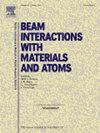A comparative study on the interaction behavior between Cr/Cu precipitates and dislocations in Iron
IF 1.4
3区 物理与天体物理
Q3 INSTRUMENTS & INSTRUMENTATION
Nuclear Instruments & Methods in Physics Research Section B-beam Interactions With Materials and Atoms
Pub Date : 2025-02-01
DOI:10.1016/j.nimb.2024.165591
引用次数: 0
Abstract
Molecular statics (MS) simulation was applied to study the interaction between ½<1 1 1> screw or ½<1 1 1>{1 1 0} edge dislocation and pure Cr/Cu precipitates in a bcc Fe matrix. The results show that there is a repulsive interaction between Cr precipitates and both types of dislocations, but an attractive interaction for Cu precipitates. With Cr/Cu precipitates continuously approaching dislocations, edge dislocation can slip due to their interaction, screw dislocation appeared core delocalization and the emission of kink pair. In all process, Cr precipitates always maintain bcc structure, but Cu precipitates are observed to occur structure transformation. At last, the results reveal that for Cr precipitate, screw dislocations have a greater repulsive force than edge dislocations, while for Cu precipitate, edge dislocations have a greater pinning force than screw dislocations.
铁中Cr/Cu相与位错相互作用的比较研究
应用分子静力学(MS)模拟研究了½<;1 1 1>;螺旋或½<;1 1 1>;{1 1 0}边缘位错和纯Cr/Cu在bcc Fe基体中析出。结果表明,Cr相与两种位错之间存在排斥性相互作用,而Cu相之间存在吸引性相互作用。随着Cr/Cu析出相不断接近位错,边缘位错由于相互作用而发生滑移,螺旋位错出现核心离域和扭对的发射。在所有过程中,Cr析出相始终保持bcc组织,而Cu析出相则发生组织转变。结果表明,对于Cr析出物,螺位错的排斥力大于边缘位错,而对于Cu析出物,边缘位错的钉住力大于螺位错。
本文章由计算机程序翻译,如有差异,请以英文原文为准。
求助全文
约1分钟内获得全文
求助全文
来源期刊
CiteScore
2.80
自引率
7.70%
发文量
231
审稿时长
1.9 months
期刊介绍:
Section B of Nuclear Instruments and Methods in Physics Research covers all aspects of the interaction of energetic beams with atoms, molecules and aggregate forms of matter. This includes ion beam analysis and ion beam modification of materials as well as basic data of importance for these studies. Topics of general interest include: atomic collisions in solids, particle channelling, all aspects of collision cascades, the modification of materials by energetic beams, ion implantation, irradiation - induced changes in materials, the physics and chemistry of beam interactions and the analysis of materials by all forms of energetic radiation. Modification by ion, laser and electron beams for the study of electronic materials, metals, ceramics, insulators, polymers and other important and new materials systems are included. Related studies, such as the application of ion beam analysis to biological, archaeological and geological samples as well as applications to solve problems in planetary science are also welcome. Energetic beams of interest include atomic and molecular ions, neutrons, positrons and muons, plasmas directed at surfaces, electron and photon beams, including laser treated surfaces and studies of solids by photon radiation from rotating anodes, synchrotrons, etc. In addition, the interaction between various forms of radiation and radiation-induced deposition processes are relevant.

 求助内容:
求助内容: 应助结果提醒方式:
应助结果提醒方式:


